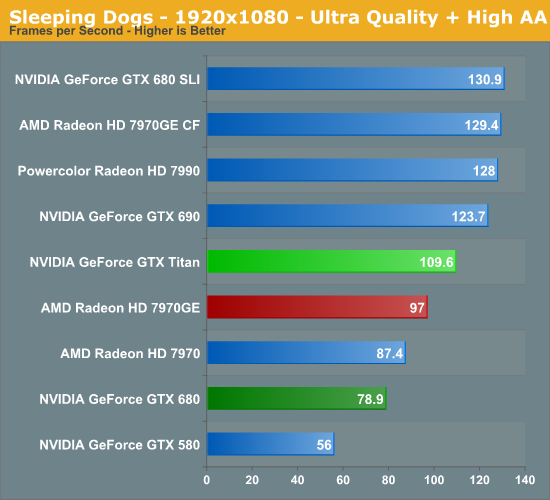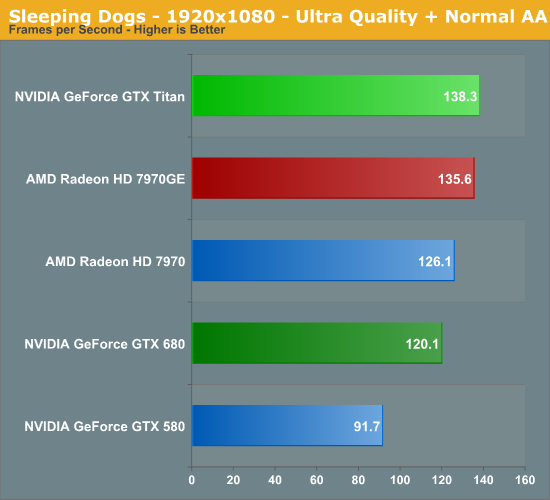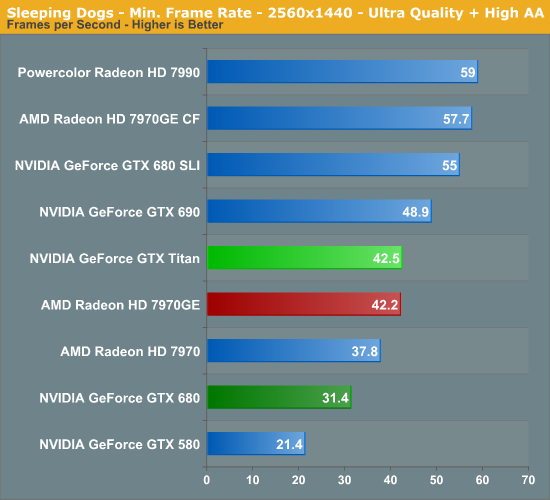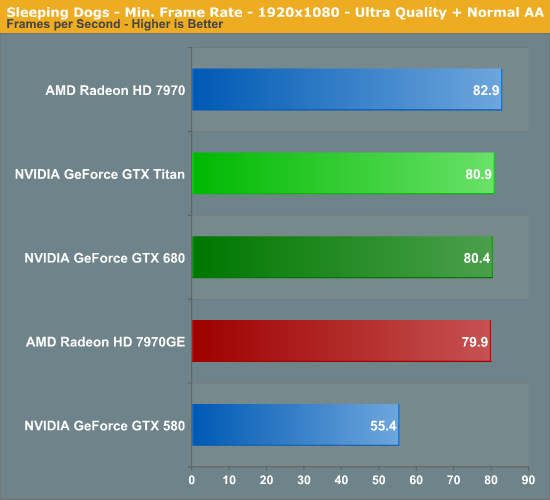NVIDIA’s GeForce GTX Titan Review, Part 2: Titan's Performance Unveiled
by Ryan Smith & Rahul Garg on February 21, 2013 9:00 AM ESTSleeping Dogs
Another Square Enix game, Sleeping Dogs is one of the few open world games to be released with any kind of benchmark, giving us a unique opportunity to benchmark an open world game. Like most console ports, Sleeping Dogs’ base assets are not extremely demanding, but it makes up for it with its interesting anti-aliasing implementation, a mix of FXAA and SSAA that at its highest settings does an impeccable job of removing jaggies. However by effectively rendering the game world multiple times over, it can also require a very powerful video card to drive these high AA modes.




Sleeping Dogs is another game that AMD cards have done rather well at, leaving the GTX 680 quite a way behind. The sheer increase in functional units for Titan means it has no problem vaulting back to the top of the list of single GPU cards, but it also means it’s crossing a sizable gap.
In the end, at 2560 at the High (second-highest) AA settings, Titan is just shy of 50% faster than the GTX 680, but a weaker 17% ahead of the 7970GE. As we drop in resolution/AA, so does Titan’s lead, as the game shifts to being CPU limited.
Notably, no single card is really good enough here for 2560 with Extreme AA, with even Titan only hitting 35fps. This is one of the only games where even with a single monitor there’s real potential for a second Titan card in SLI.
Meanwhile the gap between Titan and our dual-GPU cards is roughly as expected. The GTX 690 takes a smaller lead at 18%, while the 7990 is some 42% ahead.
Due to its built-in benchmark, Sleeping Dogs is also another title that is a good candidate for repeatable and consistent minimum framerate testing.




While on average Titan is faster than the 7970GE, the minimum framerates put Titan in a rough spot. At 2560 with high AA Titan is effectively tied with the 7970GE, and with extreme AA it actually falls behind. It’s not readily apparent why this is, whether it’s some kind of general SSAA bottleneck or if there’s something else going on. But it’s a reminder that at its very worst, Titan can only match the 7970GE.










337 Comments
View All Comments
CeriseCogburn - Tuesday, February 26, 2013 - link
I really don't understand that mentality you have. I'm surrounded by thousands of dollars of computer parts and I certainly don't consider myself some sort of hardware enthusiast or addicted overclocker, or insane gamer.Yet this card is easily a consideration, since several other systems have far more than a thousand dollars in them on just the basics. It's very easy to spend a couple thousand even being careful.
I don't get what the big deal is. The current crop of top end cards before this are starkly inadequate at common monitor resolutions.
One must nearly ALWAYS turn down features in the popular benched games to be able to play.
People just don't seem to understand that I guess. I have untold thousands of dollars in many computers and the only thing that will make them really gaming capable at cheap monitor resolutions is a card like this.
Cripes my smartphone cost a lot more than the former top two cards just below Titan.
This is the one area that comes to mind ( the only one that exists as far as I can tell) where the user is left with "my modern computer can't do it" - and that means, take any current taxing game (lots of those - let's say 50% of those reviewed as a rough thumb) and you're stuck unable to crank it up.
Now 120hz monitors are becoming common, so this issue is increased.
As you may have noticed, another poster exclaimed:
" Finally ! 1920x1080 a card that can do it ! "
There's the flat out closest to the truth, and I agree with that entirely, at least for this moment, as I stated here before the 7970 didn't do it when it was released and doesn't now and won't ever. (neither does the 680)
I'm trying to deny it, but really it is already clear that the Titan doesn't cut it for everything at the above rez either, not really, and not at higher refresh rates.
More is still needed, and this is the spot that is lacking for gamers, the video card.
This card is the card to have, and it's not about bragging, it's about firing up your games and not being confronted with the depressing "turn off the eyecandy" and check the performance again... see if that is playable...
I mean ****, that apparently does not bother any of you, and I do not know why.
Everything else in your system is capable...
This is an IMPORTANT PART that actually completes the package, where the end user isn't compromising.
HighTech4US - Thursday, February 21, 2013 - link
If it does could we see a new story on performance using NVENC across the entire Kepler line along with any FREEware/PAYware software that utilizes it. I have an older Intel Q8300 that is used as my HTPC/Living Room Gaming System and encoding videos take a long time just using the CPU cores.If getting a Kepler GPU and using NVENC can speed up encoding significantly I would like to know. As that would be the lowest cost upgrade along with getting a Gaming card upgrade.
Thanks
Ryan Smith - Thursday, February 21, 2013 - link
Yes, NVEnc is present.lkuzmanov - Thursday, February 21, 2013 - link
excellent! now make it 30-40% cheaper and I'm on board.Zink - Thursday, February 21, 2013 - link
Rahul Garg picked the lowest HD 7970 scores in both cases from the Matsumoto et al. paper. The other higher GFLOPS scores represent performance using alternate kernels performing the same calculation on the same hardware as far as I can tell. Rahul needs to justify choosing only the lowest HD 7970 numbers in his report or I can only assume he is tilting the numbers in favor of Titan.JarredWalton - Thursday, February 21, 2013 - link
Picking the highest scoring results that are using optimized cores and running on different hardware in the first place (e.g. not the standard test bed) would be tilting the results very far in AMD's favor. A default run is basically what Titan gets to do, so the same for 7970 would make sense.codedivine - Thursday, February 21, 2013 - link
The different algorithms are actually not performing the exact same calculation. There are differences in matrix layouts and memory allocations. We chose the ones that are closest to the layouts and allocations we were testing on the Titan.In the future, we intend to test with AMD's official OpenCL BLAS. While Matsumoto's numbers are good for illustrative purposes. We would prefer running our own benchmarks on our own testbeds, and on real-world code which will typically use AMD's BLAS for AMD cards. AMD's OpenCL BLAS performance is actually a little bit lower than Matsumoto's numbers so I don't think we tilted the numbers in AMD's favour. If anything, we gave AMD a bit of benefit-of-the-doubt here.
In the same vein, faster results than Nvidia's CUBLAS have been demonstrated on Nvidia hardware. However, we chose to test only using CUBLAS as all production code will typically use CUBLAS due to its reliability and support from Nvidia.
AMD's OpenCL BLAS is a bit complicated to setup correctly and in my research, I have had problems with stability with it on Windows. Thus, we avoided it in this particular review but we will likely look at it in the future.
Zink - Thursday, February 21, 2013 - link
Thanks, shouldn't have doubted you :)Nfarce - Thursday, February 21, 2013 - link
...about my 680 purchase last April (nearly a year ago already, wow). Was so worried I made the wrong decision replacing two 570s knowing the Kepler was less than a year away. The news on this card has firmed up my decision to lock in with a second 680 now for moving up to a 2560x1440 monitor.Very *very* disappointing, Nvidia.
CeriseCogburn - Thursday, February 21, 2013 - link
The new top card has been near the same as two of the former cards FOREVER.You people are nothing short of stupid nut jobs.
There are not enough tampons at Johnson and Johnson warehouses for this thread.
THE VERY SAME RATIO has occurred every time for all the prior launches.